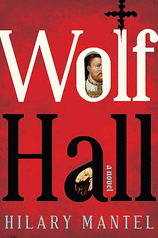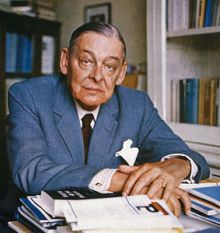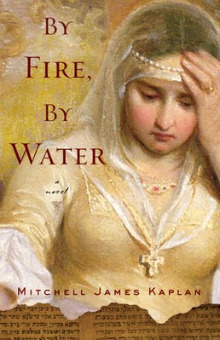Matt Rees's Blog - Posts Tagged "hilary-mantel"
What am I reading?
 On the "Writers Read" blog, which is run by the indefatigable Marshal Zeringue, the latest post features my most recent reading. It's not what you might think -- in other words, it isn't detective fiction (well, there's one such book, sort of...) and it's not full of books about the Middle East. Have a look at the historical fiction, travel writing, and investigative nonfiction recently on my nightstand (that's just a turn of phrase -- I don't have a nightstand and I don't read in bed.) Read on for the rest of my post.
On the "Writers Read" blog, which is run by the indefatigable Marshal Zeringue, the latest post features my most recent reading. It's not what you might think -- in other words, it isn't detective fiction (well, there's one such book, sort of...) and it's not full of books about the Middle East. Have a look at the historical fiction, travel writing, and investigative nonfiction recently on my nightstand (that's just a turn of phrase -- I don't have a nightstand and I don't read in bed.) Read on for the rest of my post.Matt Beynon Rees has lived in Jerusalem since 1996. He covered the Middle East for over a decade for the Scotsman, then Newsweek, and from 2000 until 2006 as Time magazine's Jerusalem bureau chief. He published his first novel featuring Palestinian detective Omar Yussef, The Collaborator of Bethlehem, in 2007, which won the CWA John Creasey (New Blood) Dagger award. A Grave in Gaza and The Samaritan's Secret followed in 2008 and 2009. The new novel in the series, The Fourth Assassin, follows Omar to visit his son in New York's "Little Palestine" in Brooklyn.
A couple of weeks ago I asked Rees what he was reading. His reply:
Wolf Hall—Hillary Mantel
Simply the best historical novel for many, many years. Mantel’s portrayal of Tudor England, through the self-made politician and courtier Cromwell, is magnificent. It won the Booker Prize, which isn’t always such a recommendation. In many of the novels chosen for the prize, linguistic flash is chosen over characterization, leaving an emotional void for the reader. But in this case the prize committee got it right. Mantel’s characters breathe, even when they’re not central. One of the amazing things she pulls off in this book is to have a very broad range of characters who, without being central, manage to be rounded, returning here and there throughout the lengthy narrative with immediate life – they don’t need to be reintroduced; we already know who they are and how they think.
Nineteen Seventy-Four—David Peace
Peace’s “Red-Riding Quartet” (which includes other books also titled after the years in which they're set) is talked about as attempting to do for the UK in the ‘Seventies and ‘Eighties what James Ellroy has done for the US in the ‘Sixties. Namely to take the history we think we know and reveal the corrupt underside of it all. He’s successful in portraying the utter decay of Britain, revealing why voters were ready for the remaking of the entire country for which they voted in 1979 with the election of Margaret Thatcher. He doesn’t quite – at least in this first volume – manage to link the lower regions of society with those who rule. There's no equivalent of Ellroy's chats between his fictional agents and J. Edgar Hoover, for example. That connection is spelled out, rather than shown. Also his period scene-setting is a little heavier than Ellroy’s – hardly a page goes by without some archetypal song of the era playing in the background on the radio or a tv show all Brits would remember going with the sound down. The biggest success of the book is creating a “hero” who’s almost – but not quite – repulsive enough for us to half-believe that he’s the serial killer.
In the Shadow of Vesuvius—Jordan Lancaster
For lovers of Italy, and most surely for those who enjoy the madhouse that is modern Naples, this cultural history of the southern Italian city is an enjoyable way to learn that it was always that way. A Paradise inhabited by devils, or a Hell that’s home to angels, as Lancaster puts it. She deals with the complexity of Neapolitan politics – through rule by Rome, various Spanish, French and Norman dynasties, and the desperate straits into which the city was cast by Italian unification – with a light touch.
Gomorrah – Roberto Saviano
Can you tell I’ve been in Naples in the last month or two? This young Italian journalist named names in his account of the Camorra, Naples’s mafia. In return he got death threats and a life in hiding under police protection. It’s a marvelous tour of the underside of a town where only last year no one could agree on where to take the trash, so it all piled up in the streets, in mounds higher and longer than buses. When you visit Naples, as friends of mine there put it, you either hate the chaos or you love it. Either way, this book reveals just why it is that the city works – or fails to do so – as it does.
Published on February 04, 2010 16:45
•
Tags:
1974, blogs, camorra, crime-fiction, david-peace, gomorrah, hilary-mantel, historical-fiction, in-the-shadow-of-vesuvius, jordan-lancaster, naples, napoli, reading, red-riding, roberto-saviano, tudor-history, wolf-hall
Stealing the novel
 If there’s one thing that authoring a series of novels will teach you, it’s that you can’t wait for inspiration. But you can prompt it, give it little electric shocks that’ll keep it bubbling within you. Here are a few methods I use to do that.
If there’s one thing that authoring a series of novels will teach you, it’s that you can’t wait for inspiration. But you can prompt it, give it little electric shocks that’ll keep it bubbling within you. Here are a few methods I use to do that.I go to the places I’m writing about. I talk to people who might be similar to (or even the basis for) my characters. I read about them and their world. I engage in the same activities in which they specialize. But I also read about entirely different subjects – so long as they’re extremely well-written.
Some of these ideas sound self-evident. I’ve written a series of Palestinian crime novels, so it stands to reason that I’ve spent the last decade and a half in Gaza, Bethlehem, Nablus, Jerusalem, tasting and smelling and talking and looking. I even force myself to read the drivel that gets written about this place in journalism and nonfiction—occasionally I come across something good, but mainly it just gets me down. How many times can you listen to a mediocre pop song? Well, that’s how most Middle East journalism sounds in my ear.
For a novel I have coming out next year about Mozart, I learned to play the piano. I learned that I wasn’t much good at it, but I also saw inside the music in a way I couldn’t have done merely by listening.
Not so obvious, however, might be the wide reading. A number of writers I’ve met or read about say they don’t have time to read anything that isn’t directly related to their research. In other words, if I’m writing about Berlin, it’s goodbye to Raymond Chandler for the next 12 months.
Well, T.S. Eliot wrote that “Immature poets imitate; mature poets steal.” I can look back at my literary efforts as an undergraduate and see what imitation there was throughout all of it. Now I’m mature (I try to fight it; I work out; but I concede, I’m maturing…) and I’ve figured out how to steal.
What Eliot meant was that it takes a while, as a writer, to realize how to make things your own. That means going beyond the plagiaristic imitation of youth, which is humble and filled with homage, to the confident sense that whatever you see another writer do, you can do it better. Then when you read something good, it doesn’t appear in your work as the same thing—it spurs you to develop your own spin on the thought that’s provoked in you by what you’ve read.
Let me give you an example. I challenge any one of you to show me a contemporary writer who can build a character in a fuller, more convincing manner than Hilary Mantel, who won the Booker Prize last year for her masterful “Wolf Hall.” If anything, her 1992 classic “A place of Greater Safety,” a novel about the French Revolution, is even more amazing than her now-famous prize-winner.
“Greater Safety” tells the story of the entire revolution through the characters of Robespierre, Danton and Desmoulins. From their childhoods to (it’s a historical novel so I don’t have to give any spoiler alerts) their executions. Each of them is built slowly, and we see their character arc in a way that even they don’t—watch their idealism tainted with violence, until it turns on them. Because we take that journey with them, we care more deeply for them, even as they become murderous and unjust.
The “stealing” comes in whenever I see a point that Mantel uses to build that empathy. Robespierre, we learn, always carries a tiny copy of Rousseau in his pocket. Some time later it’s on his desk and Desmoulins notices it. Just one sentence. A couple hundred pages later someone quotes Rousseau against him and only his close friends understand that he’s entirely defeated. We know he’s a man who has bent principles for his friend Desmoulins, but he can’t desert them completely. It’s a choice between Desmoulins, whom he loves, or the book that he keeps close to his heart. Books always win in contests like that.
That doesn’t make me want to replicate the exact same thing in my next book – that’s what I might’ve tried when I was 19. Instead, I think of ways in which to send a signal to the reader. To plant an object that inspires a character, that takes them on the path on which we follow them in the novel. Until ultimately it underlies their collision with another character; makes compromise an impossible undermining of everything they believe about themselves.
That’s stealing, and it’s a good thing to do.
You can find such moments in the small factoids of history books, if you’re researching a period, or in nonfiction. It’s in poems, where a phrase about a frieze on an urn (“Thou still unravished bride of quietness”) will spark a thought about your memories of your own wedding or of a sexual exploit which you can use for a character in your book.
A writer whose obvious focus is character would be the most direct place to start. In other words, not the kind of ultra-bland snoozing that appears in the short fiction of The New Yorker, which always seems to be written as though it were designed to mimic a relatively dull person telling you a story in a cocktail party or at the counter of a bodega.
Choose something with sweep, like Mantel. Someone with an eye for a mordant detail, like Graham Greene in “The Honorary Consul.” Someone who shows you an entire, devastated culture through the eyes of one man, like Martin Cruz Smith’s investigator Arkady Renko.
A novel’s like a marathon. Stop and sit down at the side of the road and no amount of sprinting will get you to the finish line. You have to write every day and once you’re started you can’t stop. “Stealing” is a way of warming up for the long run.
Published on April 15, 2010 00:12
•
Tags:
a-place-of-greater-safety, berlin, bethlehem, booker-prize, crime-fiction, danton, desmoulins, gaza, graham-greene, hilary-mantel, historical-fiction, israel, jerusalem, martin-cruz-smith, middle-east, mozart, nablus, novels, palestine, raymond-chandler, robespierre, t-s-eliot, wolf-hall, writing
Going historical
 Writing of the disdain expressed for genre novels by critics, Raymond Chandler said that there were just as many bad “literary novels” of the type favored by critics as there were bad genre stories – except that the bad literary novels didn’t get published. In other words, there’s nothing inherent in so-called genre fiction that makes it lesser than “literary” fiction.
Writing of the disdain expressed for genre novels by critics, Raymond Chandler said that there were just as many bad “literary novels” of the type favored by critics as there were bad genre stories – except that the bad literary novels didn’t get published. In other words, there’s nothing inherent in so-called genre fiction that makes it lesser than “literary” fiction.Chandler knew what he was talking about. His great noir novels, such as “The Big Sleep” and “The Long Goodbye,” are must-reads for anyone who wants to know how to build a sentence and a voice, how to create an image that won’t fade a few pages on, how to make people want to read it all over again. His contemporaries in the “literary” field who were more favored by the highbrow critics of his time are these days consigned to the dustbin of college literature courses. (If you don’t believe me, tell me when was the last time you reached for a volume by Upton Sinclair or Pearl Buck?)
But historical fiction is back. Ever since “The Name of the Rose” (published in English in 1983), the genre has accrued greater legitimacy. Last year’s Booker Prize went to a historical novel (“Wolf Hall”) and this year’s looks likely to go to “The Thousand Autumns of Jacob de Zoet” (do an internet search for its author David Mitchell and “genius,” and you’ll see why.)
Even poor old Alexandre Dumas and the swashbuckler have been returned from their long-ago burial under a mound of critical invective. In the last decade or so, Dumas has found his way into the title of a novel by Arturo Perez-Reverte, one of the most notable historical novelists of our time. Perez-Reverte can buckle a swash in the form of his Dumas-derived Captain Alatriste series, but he also has enough modern perversity for one of his novels to have been adapted for the screen by Roman Polanski. (That novel, “The Club Dumas,” even included a reference to Eco, “the professor from Bologna,” in a nod to his role in legitimizing the genre.)
Read the rest of this post on my blog The Man of Twists and Turns.
Published on September 01, 2010 00:06
•
Tags:
alan-furst, alexandre-dumas, arturo-perez-reverte, barbara-nadel, barry-unsworth, caleb-carr, captain-alatriste, caravaggio, crime-fiction, david-mitchell, hilary-mantel, historical-fiction, j-sydney-jones, literary-fiction, mozart, mozart-s-last-aria, new-york, omar-yussef, palestinian, pearl-buck, raymond-chandler, sacred-hunger, the-big-sleep, the-club-dumas, the-long-goodbye, the-name-of-the-rose, umberto-eco, upton-sinclair, west-bank, wolf-hall
The Inquisition, the Jews of Andalus, and Columbus: 'By Fire By Water' review
 Historical novels vie with crime and romance novels for the titles of most derided and most widely read literature. They've had a bad rap ever since the 19th century, when the swashbucklers of Alexandre Dumas looked pretty wooden next to Dickens, and cartoonish in comparison to the depth of Victor Hugo or George Eliot. There have always been marvelous exceptions, such as Mary Renault's amazing novels of ancient Greece, but for much of the last century, historical fiction was seen as pure escapism, barely distinguishable from bodice-ripping romance.
Historical novels vie with crime and romance novels for the titles of most derided and most widely read literature. They've had a bad rap ever since the 19th century, when the swashbucklers of Alexandre Dumas looked pretty wooden next to Dickens, and cartoonish in comparison to the depth of Victor Hugo or George Eliot. There have always been marvelous exceptions, such as Mary Renault's amazing novels of ancient Greece, but for much of the last century, historical fiction was seen as pure escapism, barely distinguishable from bodice-ripping romance.Since the publication of "The Name of the Rose," in 1980, the genre has gained gradual legitimacy. Much snobbishness still abounds, however, over the commercial success of historical fiction and the perceived tendency of genre writers to simplify bygone eras. Still, though Umberto Eco's book has sold 10 million copies, it undoubtedly takes some brains to appreciate it, and no one could accuse Eco of writing simplistic books. Literary highbrows came down to mix with the hoi polloi long enough to award last year's Man Booker Prize, the most notable British book award, to Hilary Mantel's "Wolf Hall," a wonderful evocation not just of Tudor England but of the contrast between a steely self-made man and a bunch of spoiled, weak upper-class brats. The legitimacy of the genre progresses this year with the deification in both the United Kingdom and the United States of David Mitchell, whose novel about Japan in 1799, "The Thousand Autumns of Jacob de Zoet," is a candidate for the Booker and who, even before this latest work, has routinely been referred to as a genius by reviewers.
Read the rest of this post on my blog The Man of Twists and Turns.
Published on September 03, 2010 04:45
•
Tags:
abdel-aziz-rantisi, alexandre-dumas, andalus, by-fire-by-water, charles-dickens, crime-fiction, david-mitchell, gaza, george-eliot, hamas, hilary-mantel, historical-fiction, inquisition, islam, jews, judaism, mary-renault, mitchell-james-kaplan, muslims, palestinians, reviews, romance-fiction, spain, the-name-of-the-rose, umberto-eco, victor-hugo, wolf-hall, zaragoza



